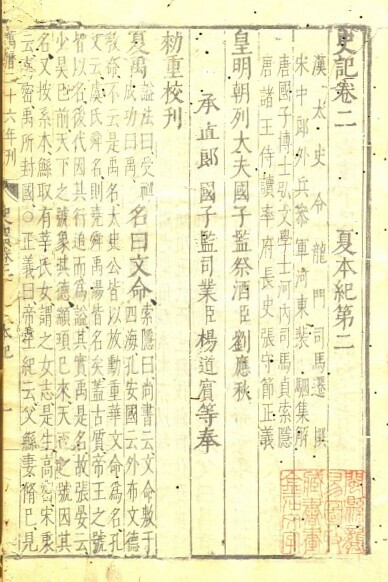|
Li Ke (general)
Li Ke ( Chinese: 里克; died 650 BC) was a general and official of the State of Jin during the Spring and Autumn period of Chinese history. Biography Li Ke first appears in history as an official and general serving Duke Xian of Jin. In the summer of 658 BC, he led an army to attack the State of Guo (虢) with the assistance of the nearby State of Yu (虞), the duke of which granted Li Ke's army military access and the right to station near the Yu capital. Soon after Guo was conquered, Li Ke conquered Yu as well. This action, known as "Obtaining safe passage to conquer the State of Guo" (假道伐虢), was later enshrined as a part of the ''Thirty-Six Stratagems.'' Duke Xian died in 651 BC. As Shensheng, the crown prince, had committed suicide, the succession had come into a state of flux. Li Ji, the late duke's wife, placed prince Xiqi, her own son with the late duke, onto the throne, but a month later, Li Ke killed Xiqi, and Chancellor Xun Xi (荀息) installed prince Zhu ... [...More Info...] [...Related Items...] OR: [Wikipedia] [Google] [Baidu] |
Chinese Language
Chinese ( or ) is a group of languages spoken natively by the ethnic Han Chinese majority and List of ethnic groups in China, many minority ethnic groups in China, as well as by various communities of the Chinese diaspora. Approximately 1.39 billion people, or 17% of the global population, speak a variety of Chinese as their first language. Chinese languages form the Sinitic languages, Sinitic branch of the Sino-Tibetan language family. The spoken varieties of Chinese are usually considered by native speakers to be dialects of a single language. However, their lack of mutual intelligibility means they are sometimes considered to be separate languages in a Language family, family. Investigation of the historical relationships among the varieties of Chinese is ongoing. Currently, most classifications posit 7 to 13 main regional groups based on phonetic developments from Middle Chinese, of which the most spoken by far is Mandarin Chinese, Mandarin with 66%, or around 800&nb ... [...More Info...] [...Related Items...] OR: [Wikipedia] [Google] [Baidu] |
Duke Mu Of Qin
Duke Mu of Qin (died 621BC), born Ying Renhao, was a duke of the state of Qin. Sometimes considered one of the Five Hegemons of the Spring and Autumn period, Duke Mu greatly expanded the territory of Qin during the reign of King Xiang of Zhou. He was also known for his many talented advisors, such as Baili Xi, Jian Shu (蹇叔), Pi Bao (丕豹), and Gong Sun (公孫). Names Ying Renhao is a Chinese name: Ying is the surname and Renhao is the given name. During his time in power, he would have simply been called Qin or the Duke of Qin (''Qingong''). The title ''Qin Mugong''—the "Solemn Duke of Qin"—is a posthumous name bestowed by his successors as part of Chinese ancestral veneration. Despite this being a descriptive title, it is common in English to treat it as though it were a common name. All of these are the modern Mandarin pronunciations of the characters in his names; their reconstructed Old Chinese pronunciations are different. Life He was the son of Duk ... [...More Info...] [...Related Items...] OR: [Wikipedia] [Google] [Baidu] |
Guoyu (book)
The ''Guoyu'', usually translated as ''Discourses of the States'', is an ancient Chinese text that consists of a collection of speeches attributed to rulers and other men from the Spring and Autumn period (771–476 BC). It comprises a total of 240 speeches, ranging from the reign of King Mu of Zhou () to the execution of the Jin minister Zhibo in 453 BC. Compilation of the ''Guoyu'' probably began during the 5th century and continued until the late 4th century BC. The earliest chapter of the compilation is the ''Discourses of Zhou''. The text's author is unknown, but it is sometimes attributed to Zuo Qiuming, a contemporary of Confucius Confucius (; pinyin: ; ; ), born Kong Qiu (), was a Chinese philosopher of the Spring and Autumn period who is traditionally considered the paragon of Chinese sages. Much of the shared cultural heritage of the Sinosphere originates in the phil ...; although as early as Jin dynasty, Fu Xuan objected to that attrib ... [...More Info...] [...Related Items...] OR: [Wikipedia] [Google] [Baidu] |
Records Of The Grand Historian
The ''Shiji'', also known as ''Records of the Grand Historian'' or ''The Grand Scribe's Records'', is a Chinese historical text that is the first of the Twenty-Four Histories of imperial China. It was written during the late 2nd and early 1st centuries BC by the Han dynasty historian Sima Qian, building upon work begun by his father Sima Tan. The work covers a 2,500-year period from the age of the legendary Yellow Emperor to the reign of Emperor Wu of Han in the author's own time, and describes the world as it was known to the Chinese of the Western Han dynasty. The ''Shiji'' has been called a "foundational text in Chinese civilization". After Confucius and Qin Shi Huang, "Sima Qian was one of the creators of Imperial China, not least because by providing definitive biographies, he virtually created the two earlier figures." The ''Shiji'' set the model for all subsequent dynastic histories of China. In contrast to Western historiographical conventions, the ''Shiji'' does no ... [...More Info...] [...Related Items...] OR: [Wikipedia] [Google] [Baidu] |
Zuo Zhuan
The ''Zuo Zhuan'' ( zh, t=左傳, w=Tso Chuan; ), often translated as ''The Zuo Tradition'' or as ''The Commentary of Zuo'', is an ancient Chinese narrative history traditionally regarded as a commentary on the ancient Chinese chronicle the '' Spring and Autumn Annals''. It comprises 30 chapters covering the period from 722 to 468BC, and focuses mainly on political, diplomatic, and military affairs from that era. For many centuries, the ''Zuo Zhuan'' was the primary text through which educated Chinese learned their ancient history. The ''Zuo Zhuan'' does not simply explain the wording of the ''Spring and Autumn Annals'', but rather expounds upon its historical background with rich and lively accounts of the history and culture of the Spring and Autumn period (771476 BC). The ''Zuo Zhuan'' is the source of more Chinese sayings and idioms than any other classical work, and its concise, flowing style served as a paragon of elegant Classical Chinese. Its tendency toward thi ... [...More Info...] [...Related Items...] OR: [Wikipedia] [Google] [Baidu] |
Duke Hui Of Jin
Duke Hui of Jin, personal name Ji Yiwu, was duke of the Jin state from 650 BC to 637 BC. Life Early life Yiwu was one of the nine sons of Duke Xian. His mother was Xiao Rongzi. He was the younger sibling of Shensheng and Chong'er (later Duke Wen) and the older sibling of Xiqi. As part of her scheme to secure the succession to her son, the concubine Li Ji removed Xiqi's older siblings from the capital on the pretext of pacifying their territories. Prince Yiwu was sent to defend Erqu in what is now Ji County, Shanxi. After the death of Duke Xian in the ninth lunar month during 651BC, Li Ji placed the 15-year-old Xiqi on the throne and made Xun Xi chancellor to help him with administration. In the tenth lunar month of 651BC, before Duke Xian had even been properly buried, a Jin minister named Li Ke killed Xiqi. The chancellor Xun Xi then placed Zhuozi, the youngest son of Duke Xian, on the throne even though he was still just a toddler at that time. Xun Xi then fi ... [...More Info...] [...Related Items...] OR: [Wikipedia] [Google] [Baidu] |
Duke Wen Of Jin
Duke Wen of Jin (697–628BC), personal name Ji Chong'er, was duke of the Jin state from 636 BC to 628 BC. He was exiled from Jin for approximately 20 years before finally assuming the throne and rapidly leading Jin to hegemony over the other Chinese states of his time. Duke Wen is a figure in numerous Chinese legends, including those about his loyal courtier Jie Zhitui, whose death is said to have inspired China's Cold Food Festival and Qingming Festival. Names "Duke Wen of Jin" is a posthumous name bestowed on him as part of his family's ancestral veneration. It literally means the "Cultured Duke of Jin". Duke Wen's given name was Chong'er. His clan name was Ji. Life Early life Prince Chong'er was born to Duke Xian of Jin in 697 BC. The '' Zuo Zhuan'' notes that "his ribs were all grown together," a sign of strength and leadership. Chong'er's half-brothers included Shensheng and Xiqi. While Shensheng was the original crown prince, in his later years Duke Xian ... [...More Info...] [...Related Items...] OR: [Wikipedia] [Google] [Baidu] |
Jin (Chinese State)
Jin (, Old Chinese: ''*''), originally known as Tang (唐), was a major Ancient Chinese states, state during the middle part of the Zhou dynasty, based near the centre of what was then China, on the lands attributed to the legendary Xia dynasty: the southern part of modern Shanxi. Although it grew in power during the Spring and Autumn period, its aristocratic structure saw it break apart when the duke lost power to his nobles. In 403BC, the Zhou court recognized Jin's three successor states: Han (Warring States), Han, Zhao (state), Zhao, and Wei (state), Wei. The Partition of Jin marks the end of the Spring and Autumn period and the beginning of the Warring States period. Geography Jin was located in the lower Fen River drainage basin on the Shanxi plateau. To the north were the Xirong and Beidi peoples. To the west were the Lüliang Mountains and then the Loess Plateau of northern Shaanxi. To the southwest the Fen River turns west to join the south-flowing part of the Yello ... [...More Info...] [...Related Items...] OR: [Wikipedia] [Google] [Baidu] |


